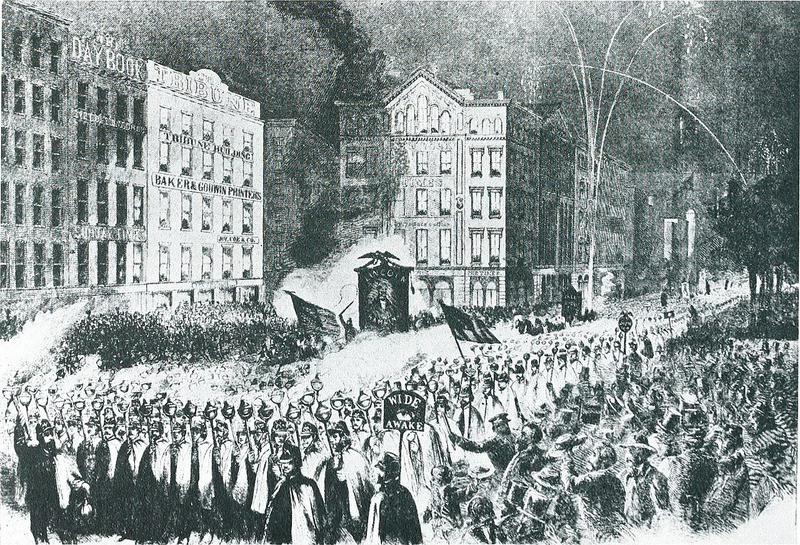The Wide Awakes: A Pre-Civil War Political Movement
By | October 27, 2022

The Wide Awakes formed in early 1860, when Cassius Clay, a Kentucky abolitionist, visited Hartford, Connecticut to campaign for the Republican gubernatorial candidate. He was accompanied by some young men who would later form the first Wide Awake Club; those first 36 members bought their own capes, which became an integral part of their uniform. On the night of March 5, when Lincoln visited Hartford to speak against the spread of slavery and in support of workers’ rights, they escorted him to his hotel.
The Republicans Adopted Their Message
Three years before the formation of the Wide Awakes, the Dred Scott decision ruled that African Americans could not become citizens or hold any rights. During this time, politicians began to recognize the importance of the young vote, as 51% of the populace was 19 or younger. The youth began to join voices like Lincoln and others who were protesting the injustice. Though they were not technically a part of the Republican party, they did love Lincoln, and the Republican leaders, recognizing the growing popularity of the movement, adapted their message to suit the party’s needs, as election season was approaching.

What They Did
The New York Times described the Wide Awakes as “young men of character and energy, earnest in their Republican convictions, and enthusiastic in prosecuting the canvass on which we have entered.” The Lincoln campaign seized on their idea, and decided to develop groups of them across the country to launch voter registration drives; they understood that these young groups would attract new, young voters. In Chicago, by October 3, 1860, 10,000 Wide Awakes marched in a rally that was three miles long. The Wide Awakes also served as political police, helping to preserve order, and escorting speakers. By the election, they appeared at voting booths to ensure the elections were fair. Their rallies had well-organized parades down banner-bearing streets, featuring floats, bands, torchlight processions, and fireworks. By the time Lincoln was elected, the Wide Awakes boasted 500,000 members. Although they had spread to every major Northern city by the summer, some Northerners were a bit disturbed by the movement.
Their Uniform
The Wide Awakes had a standard uniform: a full robe or cape, a black hat, and a six-foot long torch with a pivoting, flaming whale-oil container. Their oilcloth capes protected them from the oil that dripped from their lamps, however the light reflected off the capes, which may have added to their appearance. They were mainly active at night, and had nighttime torch-lit marches in northeastern cities. As for their banner, they used the image of a large eyeball. The groups used new methods of communication, such as an early comic book, Pipps Among the Wide Awakes. They also used “moving transparencies” which could be considered a distant ancestor to motion pictures. Additionally, they printed sheet music, which was sent around the country.
Organization
They had no known formal governing body, and they seemed to have been organized into local chapters; they used a military-style officer system. Membership was restricted to males aged 18 or older. However, after a club was organized, one of the first orders of business was to invite young women to the meetings. There were groups of “Lady Wide Awakes” that formed. Susan B. Anthony and Elizabeth Cady Stanton addressed a rally in Seneca Falls, New York, and African Americans joined the clubs occasionally.

Unofficial Mission Statements
The individual chapters typically adopted an unofficial mission statement, which outlined their roles, such as acting as a political police, escorting Republican speakers to events, keeping order in public events, conducting themselves in such a way that all Republicans would want to join them, and working for the good of the Republican Ticket. Occasionally, they acted as paramilitary; for example, the St. Louis chapter helped to protect the federal St. Louis Arsenal, which the Confederates wanted to seize.
The South Feared Them
The Wide Awakes did not march in the South, but the Southern landowners feared them, because they were worried that they would march south, steal the land, liberate the slaves, and destroy their way of life. Their uniforms further incited fear because Southerners believed that “they parade at midnight, carry rails to break open our doors, torches to fire our dwellings, and beneath their long black capes, the knife to cut our throats.”
Formation Of The Minutemen In Reaction
In reaction to the Wide Awakes, which the South viewed as the North’s private army, the South created the “Minutemen,” a “counteracting organization in the South.” As they said, they would no longer tolerate the “abhorrence of the rapine, murder, insurrection, pollution and incendiarism which have been plotted by the deluded and vicious of the North, against the chastity, law and prosperity of innocent and unoffending citizens of the South.” The Minutemen were expected to defend the South if necessary. Like the Wide Awakes, they held torch rallies, and they had their own uniforms, including a badge of a blue rosette worn on the side of their hats.
After the war, the movement began to fade, although the changes that they helped to bring about remain.